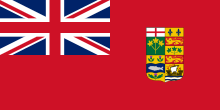

 |
| Part of a series on |
| Peerages in the United Kingdom |
|---|
| House of Lords |
Canadian peers and baronets (French: pairs et baronnets canadiens) exist in both the peerage of France recognized by the Monarch of Canada (the same as the Monarch of the United Kingdom) and the peerage of the United Kingdom.
In 1627, French Cardinal Richelieu introduced the seigneurial system of New France. Almost all of the early French Canadians who came as officers in the military or filled important official positions within the colony in New France came from the ranks of the French nobility. Under the Ancien Régime, several of these men were promoted to more senior ranks within the peerage of France. From the early 1700s, it became customary for the governors of New France to be given the title marquis. Except for the Marquis de Vaudreuil and the Marquis de Beauharnois, most were in Canada only for a few years before returning to France and are therefore not counted as Canadians.
The Baronetage of Nova Scotia (a British hereditary title, but not a peerage) had been devised by King James VI and I in 1624 as a means of settling Nova Scotia. Except for Sir Thomas Temple, almost none of them came to Nova Scotia, therefore they are counted as British, not Canadian.
Following the British Conquest of New France in 1763, the likes of The 1st Baron Amherst and The 1st Baron Dorchester were raised to the Peerage of Great Britain for their part in the taking of Canada and as Governors General of Canada, but they were not Canadians. As the colony grew under British rule both in terms of geography and economy, baronetcies began to be conferred upon various Canadian politicians, military commanders and businessmen.
In 1891, Lord Mount Stephen became the first Canadian to be elevated to the peerage of the United Kingdom. The significant losses of the First World War included many direct heirs to titles and some replacements were found in Canada, resulting in the acquisition of titles by Canadians.
After the controversial elevation of Lords Atholstan and Beaverbrook to the Peerage of the United Kingdom, the Nickle Resolution was presented to the House of Commons of Canada in 1917 requesting the Sovereign not to grant knighthoods, baronetcies or peerages to Canadians. This triggered the Canadian titles debate and led to a separate system of orders, decorations, and medals for Canada. Canadians who were granted peerages after that date had to hold or acquire British citizenship, such as The 1st Baron Thomson of Fleet. However, the 1946 Canadian Citizenship Act provided that Canadians who acquired another citizenship by any means other than marriage had renounced their Canadian citizenship. The 1977 Citizenship Act undid this provision.
